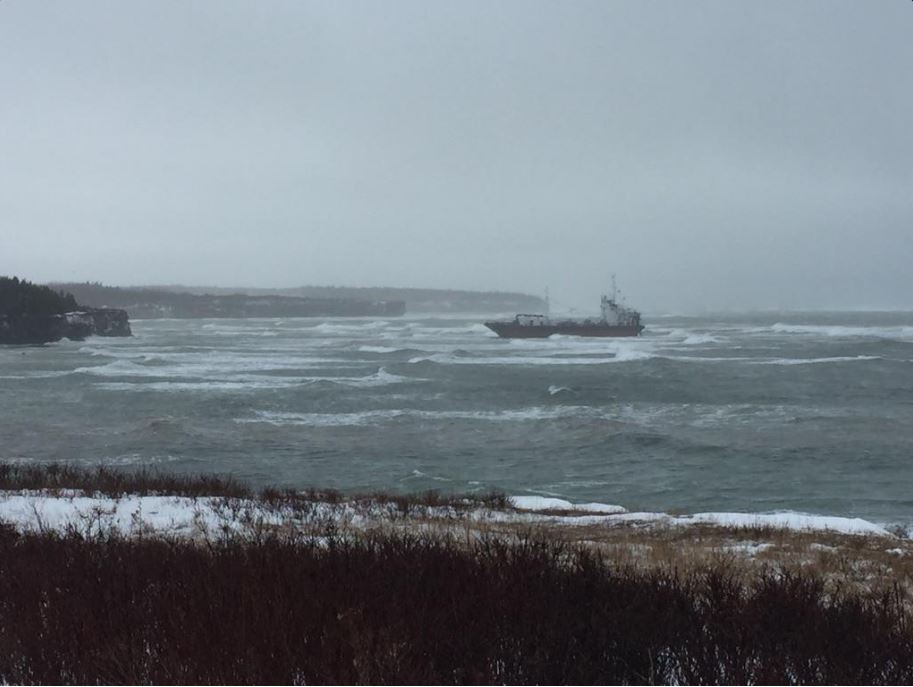Veteran mariners are questioning why a tanker that operated in calm harbours was permitted to attempt a winter crossing of the Gulf of St. Lawrence waters, as plans continued Thursday to pull the grounded ship off a sandy Cape Breton bottom.

READ MORE: Larger tug to be used to shift grounded tanker off Cape Breton
Coast guard officials are optimistic a second towing attempt expected on the weekend will shift the double-hulled Arca 1 – which holds 15 tonnes of its own fuel.
However, with memories still fresh of the taxpayer-funded cleanup of the MV Miner – which broke free from a tow line and ran aground in 2011 off Cape Breton – seafarers’ advocates argue the incident shows Canada must tighten oversight of foreign flagged vessels travelling its coasts.
Patrice Caron of the Seafarers International Union says when he worked aboard the Arca 1 in the early 1990s, it wasn’t intended to make the crossing of the often wild waters northeast of Cape Breton’s coast.
He recalled it as a flat-bottomed vessel with two outboard propulsion units that was used to deliver fuel in the relatively calm waters of inland harbours.
READ MORE: Tow of tanker grounded off Cape Breton unsuccessful, operations suspended
“When I saw the news I couldn’t believe it. This vessel should remain in certain parameters of the coast, and it’s not meant for the open sea,” he said in a telephone interview from the union office in Montreal.
“If they wanted it somewhere else, they should have used a sea tug to take that barge out. It shouldn’t be going on its own.”
The coast guard has said the vessel was in transit to its Mexico owner Petroil Marine, which has declined all comment on the incident.
After it went aground on Sunday, six crew were airlifted to safety by Cormorant rescue helicopters.
Patrick Gates, president of Master Mariners of Canada, said he and other members of his association – which includes some of the country’s senior sea captains – also question how the ship was allowed to proceed to the open ocean.
READ MORE: Salvage firm plans tow of grounded tanker off Cape Breton after assessing hull
He said his association had heard the ship was only to transit during daytime hours, but it was still a case where a tug escort would have been wiser.
“I’m amazed it was given a certificate to transit … I think the ship owner has a lot of questions they need to answer as to why they were trying to do it this way,” he said in an interview from Halifax.
When asked about the vessel’s seaworthiness, a spokeswoman for Transport Canada sent an email stating the vessel was inspected in Sorel, Que., in December, and passed the standards set by Panama.
“The results of the inspection were reported back to the Panama Maritime Authority, which determines and imposes the vessel’s operational requirements,” wrote spokeswoman Natasha Gauthier.
However, Karl Risser, the East Coast representative for the International Transport Workers’ Federation, says passing the standards of a small Central American nation for a North Atlantic journey isn’t sufficient.
“They (Transport Canada) could have insisted the vessel be towed … They have control over whether the vessel can come and go in the ports. They have an ability to check the vessel before it leaves ports to makes sure it is safe for the voyage,” he said in an interview from Vancouver.
READ MORE: Coast Guard hopes to tow tanker that ran aground off Nova Scotia coast
He argues that once the vessel is brought to Sydney harbour, Transport Canada must re-inspect it and reconsider whether it be permitted to continue steaming south under its own power to its new owners.
“It’s a foreign owner, under a flag of convenience, who just wants to get that vessel down to the Caribbean,” he said.
Transport Canada registration records indicate the Arca 1 was shifted to foreign registration on Oct. 17, a few months before the attempted journey, while the website MarineTraffic.com says the vessel was built in 1963 and equipped in Montreal.
When it ran aground on Sunday, the coast guard said the vessel was experiencing mechanical difficulties and had lost engine power on its outboard engines.
- What is a halal mortgage? How interest-free home financing works in Canada
- Ontario doctors offer solutions to help address shortage of family physicians
- Capital gains changes are ‘really fair,’ Freeland says, as doctors cry foul
- LGBTQ2 rallies will be held across Canada next month. Here’s what to know
Keith Laidlaw, a spokesman for the Canadian coast guard, said in a briefing on Thursday that the agency has no comment on whether the Arca 1 was seaworthy for the Gulf of St. Lawrence journey.
He confirmed the salvage firm McKeil Marine will be using its more powerful tug to move the Arca 1 off the beach where it has been lodged, after an unsuccessful attempt earlier in the week.
Laidlaw says the next attempt requires a longer tow line and additional pumps to remove the ballast water, as several of the internal pumps on board the Arca are not working.
READ MORE: 6 crew members rescued from run-aground tanker off Nova Scotia coast
The timing will depend on weather conditions but is likely to be on the weekend.
Geoff MacLellan, Nova Scotia’s minister of Transportation, said the groundings of the MV Miner and the Arca 1 differ because the Arca’s owner has indicated it will cover any costs of the salvage operation, while the province is still attempting to recover costs of the $11.9 million cleanup for the MV Miner from the federal government.
Nonetheless, he says the province is watching the latest incident carefully.
“Clearly the people on the ground are doing their work but every hour that goes by there is obviously a cause for concern,” he said.



Comments